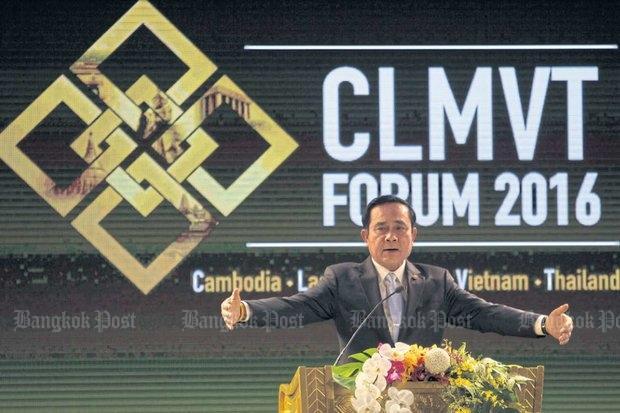Burma and four of its Southeast Asian neighbours are being urged to embark on a new journey of mutual trade, using more technology to link trade information, jointly developing regional products, and tackling non-tariff barriers.
The five countries of the CLMVT (Cambodia, Laos, Myanmar, Vietnam and Thailand) grouping were recommended at a forum in Thailand to improve their border trade facilities and invest more in human capital to support industrial development in the region, while greater cooperation is needed between tourism and sports ministries to actively promote a sustainable tourism business.
Nguyen Cam Tu, deputy minister of industry and trade for Vietnam, said massive spending to construct roads is no longer needed. Such budget should go towards adopting new technology to facilitate trade information connections and sharing among CLMVT.
“Cooperation is desperately needed,” he said. “We need close discussion on issues such as how to pick two to three outstanding products to be developed regionally. Each government also needs to come up with convenient laws and regulations to support joint development.”
Somchith Inthamit, deputy minister of industry and commerce for Laos, said regional development should be conducted on an equal basis, not leaving any countries behind. He spoke at the two-day CLMVT Forum 2016: Towards a Shared Prosperity, which started yesterday.
Information sharing should also include agricultural know-how as it can be a key channel to promote mutual development, said Somchith.
Doan Duy Khuong, vice-president of the Vietnam Chamber of Commerce and Industry, suggested in cases where the five countries make similar products they should focus on joint research and development to cope with market demands.
“For rice, Thailand and Vietnam are two of the world’s biggest rice producers, and they should work closer to reinforce each other’s strengths and address their weaknesses,” he said.
Improving border trade
Shiro Sadoshima, Japan‘s ambassador to Thailand, said Japanese investors see the Mekong subregion not only as a production and export base, but also as a growing consumer market with a population of more than 300 million people.
He said the region benefits from its geographic location, which should support growing trade with China and India.
Sadoshima urged countries in the region to follow the directions for policies suggested in the “Mekong Industrial Development Vision”.
The plan, which was adopted at the Mekong-Japan Economic Ministers’ Meeting held in Malaysia in 2015, recommends a path to industrial development in the Mekong region over five years from 2016 to 2020.
“Through implementation of this vision, the economy of the Mekong region is expected to grow by approximately US$20 billion by 2020, equivalent to 2 percent of the region’s GDP,” he said.
Sadoshima said the plan suggested Mekong countries put more emphasis on the mandates of the Cross‐Border Transport Facilitation Agreement to facilitate trade within the region.
He said recent research done on the transportation of goods from Vietnam to Thailand passing through Cambodia showed connectivity between the countries was insufficient.
The route measures 1,429 km and passes through two border customs checkpoints. The shipment took 40 hours in transit, of which almost 10 hours was spent on border customs procedures.
Another factor to boost economic development is more investment in human capital, which remains low in the region, said Sadoshima. Human capital, especially researchers and engineers, are crucial to the development of the industrial sector in the long term, he said.
“Vietnam and Malaysia have already started to invest a larger amount of money in human capital development, and we suggest other countries follow their lead,” said Sadoshima.
Joint tourism promotion
Thailand’s Tourism and Sports Minister Kobkarn Wattanavrangkul said greater cooperation is needed between tourism and sports ministries in the five countries to actively promote a sustainable tourism industry.
Formulating tourism development policies, including building ecotourism environments and establishing a tourist information pool, will be key issues for discussion among the five tourism ministries soon.
“We aim to increase the number of intra-regional tourist flows through the region by 4 percent to 8 million in 2017,” she said. “The Thai government is prioritising tourism development in the national agenda through a collaboration with other 10 local ministries, she said.
[related]
Kobkarn said the number of tourist arrivals to the 10 Association of Southeast Asian Nations (ASEAN) countries totalled 200 million in 2015, 46 percent of whom — 92 million — came from ASEAN, to which the CLMVT countries belong.
A slew of proposals were raised by member countries at the forum to encourage greater transport infrastructure between neighbouring countries and reduce unnecessary measures for international tourist arrivals such as visa approval processes.
Establishing a tourist information pool among member countries should facilitate development of the tourism industry, she said.



